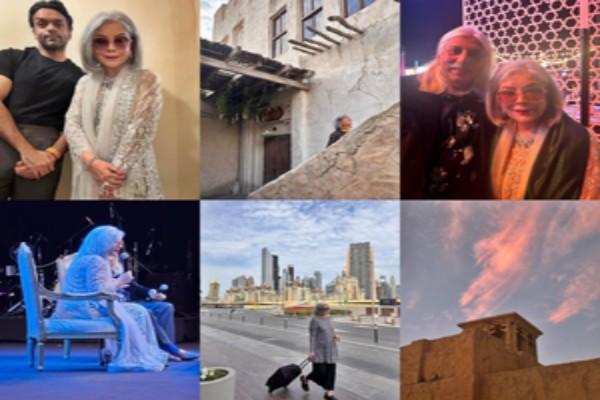
When Saigal Met Ustad Faiyyaz Khan: The Iconic Encounter in Calcutta
#Vikas Datta
Soon after he revolutionised Indian film music with 'Babul mora naihar', top classical musicians, meeting in Calcutta, decided that Ustad Faiyyaz Khan, who had sung the thumri earlier, should tie a ritual thread to K. L. Saigal to signify discipleship. The Ustad wanted to meet the singer alone first, and after an hour, someone checked to find that both, in high spirits, were insisting on calling each other their ustad.
This was revealed by santoor maestro Pandit Shivkumar Sharma, who heard it from music director S. D. Burman, a disciple of top ustads then and an eyewitness, but a more attested incident is of the Ustad, doyen of the Agra Gharana, telling Saigal that he had nothing to teach him that would make him a greater singer.
Then, Ustad Abdul Karim Khan, of the Kirana Gharana, visited a cinema hall for the first time only to hear Saigal's rendition of a song in 'Devdas' (1935) and was moved to tears.
That was the prowess of Kundan Lal Saigal, born on this day (April 11) in Jammu in 1904, and went on to become Hindi cinema's first - and sole - male singing superstar, and a significant cultural icon.
In the film industry, all major singers who followed him - Mukesh, Mohd Rafi, Talat Mehmood, and Kishore Kumar - wanted to emulate him, and Rafi counted it a major achievement to sing in the chorus of one of his songs.
On the other hand, Lata Mangeshkar, who was five when she saw him on screen, solemnly declared that she wanted to marry him when she grew up!
But Saigal's path was not easy or straight as he tackled the challenges of his changing voice in adolescence, his father's opposition to his musical passion, and a variety of jobs - from railway timekeeper to typewriter salesman to hotel manager - before his tryst with films.
He was twice rejected by HMV, then India's biggest music recording company, for "lack of training". Yet, he was so proficient in pitch that musicians used to tune their instruments by asking him to sing a note. He also became the first non-Bengali allowed to render 'Rabindrasangeet' with Rabindranath Tagore himself giving him permission.
HMV's loss was Hindusthan Records' gain and he became a top-selling artiste for them. One 1933 record, containing just the bandish 'Jhulana Jhulao Re' and bhajan 'Hori O Brajraj Dulare' on the flip side, sold a whopping half a million pieces in the days when gramophones were rare.
Then to him, goes the credit for giving a new life to the ghazal and enabling all of India to hear his renditions of Mirza Ghalib, right from 'Nuktacheen hai gham-e-dil' from 'Yahudi Ki Ladki' (1933) - his first hit.
However, succeeding ages have not been very fair to Saigal. If not forgotten, he is mocked, or at best, parodied as an exponent of "old-fashioned" sorrow and pathos-imbued songs, especially his swan song 'Jab dil hi toot gaya' from 'Shahjehan' (1946) - where he did not play the title role!
But then, Saigal is never for the superficial listener. As all accounts of him and his singing agree, he requires a measured and mellow outlook to appreciate, and his baritone/tenor mix, with just the slightest hit of a twang, slowly entrances you with his intensity and intricate art.
In a career lasting just a decade and a half, spanning Calcutta and Bombay, and comprising 36 films - 28 Hindi, 7 Bengali, and one Tamil - he sang 185 songs, including non-film, in Hindustani, Bengali, Punjabi, Tamil, as well as Persian and Pashto.
These include rare gems like 'Dukh ke ab din beetat nahi' ('Devdas', 1935), 'Ek bangla bane nyara' ('President', 1937), 'Karoon kya aas niras bhayi' ('Dushman', 1939), 'Ae qatib-e-taqdeer' ('My Sister', 1943), among others.
Then there was 'Mai kya janoon kya jadoo hai' ('Zindagi', 1940), with the various shades he imbued in the second 'kya' - which is not easy to sing, or 'Diya Jalao' ('Tansen', 1943), where he emotes perfectly - especially where he seems a bit unsure of the raga's potency and closes his eyes mid-note.
Then there is the breezy 'Mere Sapnon ki Rani' (Shahjehan) - where Rafi debuted as a chorus singer, and 'Hum apna unhein bana na sake' from 'Bhanwara' (1944) where he laughs mid-song.
And while he rendered many Ghalib ghazals, his version of Zauq's 'Laai hayat aaye..' is matchless.
However, his liquor habit - though he was not a heavy drinker - led to his health deteriorating in December 1946, and he returned to his hometown Jalandhar, where he passed away on January 18, 1947, aged just 42.
Naushad, his composer for 'Shahjehan', penned the perfect epitaph: "Aisa koi fankar-e-mukammal nahi aaya/ Naghmon ka barasta badal nahi aaya/ Mausiqi ke maahir bahut aae lekin/ Duniya mein koi doosra Saigal nahi aaya."
(Vikas Datta can be contacted at [email protected])
*Except for the heading, this story has not been edited by The enewstime.in and has been published from IANS feed.











